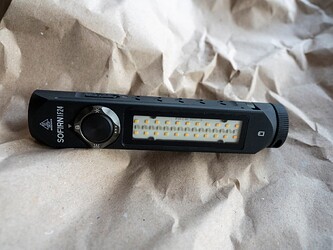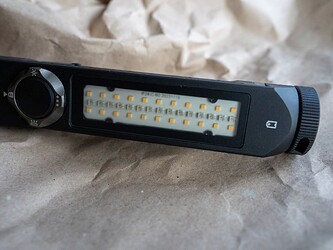Sofirn has sent me with one of their most recent flashlights, the IF24, for review purposes. The review is honest and was not influenced by any means.
They have also provided with a discount code, so make sure to use that in case you find this flashlight interesting.
IF24 on Sofirnlight: https://www.sofirnlight.com/products/sofirn-if24-rgb-flashlight-2000lm
IF24 on Amazon: Amazon.com Page Not Found
Discount code: 10BDIF24(10% OFF)
What’s in the box:
In the box are included: the flashlight, 18650 battery (3000 mAh), clip, manual, USB Type-C cable, two extra o-rings and a lanyard
Specs:
- Emitter: 1x SST40 6000-6500K, 22x CSP1313 5000K, 15x FY-1615RGY RGB LED
- Battery type: 1x 18650
- Dimensions: 27.5mm x 24.5mm x 126mm
- Weight: 95g (without battery)
- Max. output:
Main Light: 2000lm (Turbo), 700lm (High), 150lm (Medium), 10lm (Low), 1lm (Moonlight) - Runtimes:
Main Light: 1h 30min (Turbo), 2h 15min (High), 13h 30min (Medium), 115h (Low), 20d (Moonlight)
Side Light: 3h 30min (Turbo), 5h 30min (High), 12h (Medium), 58h (Low), 20d (Moonlight)
RGB: 30h - Water resistance: IP66
A closer look:
I could say the overall design is not something we see every day in flashlights. The barrel is flat on 3 out of 4 sides (one side for the side light bar and two sides for the grips) and round of the fourth side.
The finish is very smooth and pleasant to the touch and the two grip sides also have some texture cuts for better gripping. The barrel is quite long, considering it’s a single 18650 cell inside and symmetrical lengthwise with only the battery cap breaking the symmetry and adding some extra length on one side.
Near the rear end there is the removable clip location, sadly it’s not rotatable, it can only be attached on one position. Interestingly, the lanyard hole is at the battery cap, I don’t use lanyard usually but I do not like that design choice there, I could see the battery cap unscrewing in case someone has the lanyard attached to it.
On one side we can find the USB type-C charging port and the LED indicator next to it.
On the front there is the main emitter and a smooth reflector can be found on it.
Οn the main side there is the rotary switch with the e-switch and the side light bar. And here is my main criticism about this flashlight. At least for me, I find it very awkward to have the light bar and the switch on the same side. I understand that from design point of view it makes sense to put them on the same side but from practicality perspective I find it not the best choice. Holding the flashlight on hand with the thumb on the switch (which is a very reasonable holding position), it is very easy to switch on the side light bard and accidentally blind your self while looking on how to rotate the rotary switch. I would much prefer it to have the side light bar and the switches on different sizes to prevent exactly this. To make it even worse, imagine how bad it could be wanting to see the rotary switch when the side light is in high mode. I feel like this is a big design neglect on that aspect that heavily affects functionality.
User interface/Operation/Controls:
So, this is where things get interesting. We have a very nice and big e-switch (textured metal) with very satisfying click sound and feeling and around it we have a rotary switch with 4 positions (off, main light, side light, RGB side light). For the OFF option there is a nice lock symbol, a nice bright spot for the main light, a bar shining light means it’s the option for the side white light and the 3 dots corresponding the RGB options.
The controls split to the two different switches: the main switch and the rotary switch. The rotary switch is pretty simple, just choose the desired light source (main light, side white light or side RGB) or flashlight lock. Then the main switch works like one would commonly find in flashlights with not a very sophisticated UI, single click for On/Off, double click to switch between strobes (or light modes in RGB), press and hold to cycle between intensities (main and side light). Moonlight and turbo can both be accessed from Off (press and hold and double click respectively), which is always nice to see. There is a memory mode enabled but the manual does not state if you can toggle that.
Charging:
The battery can be removed and be charged by any usual battery 18650 charger. However, there is also the option to charge the battery while still within the flashlight by using the built-in USB type-C port. Personally, I always welcome charging ports on flashlights, not everyone might need one but it’s useful for people who don’t have an external battery charger, people who might only have one flashlight and can’t justify the purchase of a charger or just for a quick charge on the go. In the box a USB type-A to type-C cable is included. I believe that with the adoption of the type-C, type-C to type-C is getting more and more common. Fortunately, I found that IF24 can get charged by any USB type-C charger, which for me it’s great news, it’s such a let down when a device has USB type-C and will only charge from type-A. I have no sophisticated equipment, but a simple power measuring device showed around 10W of charging speed when the battery was on the empty side.
Additionally, you can operate the flashlight without any battery, just by attaching the USB cable to the flashlight.
Beam quality:
We can find an SST-40 as a main emitter at 6000K-6500K white temperature. While personally I’m not a big fan of cold white emitters, I have to say Sofirn hasn’t disappointed me with their lights yet. The beam quality is pretty even and pleasant for such a cold white and I can find no weird green or yellow in it. The emitter choice in combination to the optic are certainly geared towards the throw side of the spectrum. I would say that for this particular model that choice makes more sense, since the side light is by default on the very flood side.
Now for the side light, we can find 22 smaller emitters behind a frosted piece of acrylic. The result is a very flood beam which complements nicely the more throw main emitter, making the flashlight more versatile and giving you the option to pick something for your needs.
I find the side light quite pleasant and useful (when combined with the magnetic tail it can be attached to several surfaces). My feeling is that the frosted cover could be some thick or semi-opaque as you can see the individual emitters. This is not that bad until you see the effect of this in action, it creates many tiny shadows (each created by a different emitter). It’s not a deal breaker but I personally find it bothering me more than I would have thought.
I have no comments for the RGB, I don’t think I would have a use for them but it’s nice to also have that.
Conclusion:
IF24 has a quite interesting concept for a flashlight, attempting to cover both short and long distances at the same time. With a main light aimed towards throw and a side light bar aimed towards flood its goal is to be a more versatile pocket flashlight. The addition of RGB would also interest some people, personally I find no use of it. I always welcome the existence of charging port, much more in the case it is compatible with the more modern type-C. There is no fancy UI inside but there is a nice rotary switch to cycle through all the modes and 5 total levels if you include Turbo and Moonlight.
Pros-Cons:
+smooth finish
+nice flood light from side light bar
+USB type-C charging port
+battery and charging cable provide everything needed
~RBG mode could interest some users
~I would like thicker plastic on the side light, it is quite easy to see the individual emitters and they cast fuzzy shadows
~I would prefer the rotary switch to actually lock the flashlight, but I guess you also need to turn on by the main switch so it’s more secure than most other lights
-I do not like the switch and side light bar placement. Very easy to blind yourself when you switch on the side light










